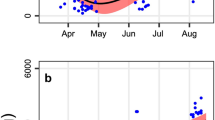Abstract
IN elephant seals (Mirounga leonina, Linn.), there is an enormous development of the hypodermis in which all the dissectible body fat is deposited. The subcutaneous fat layer acts as a physical insulator1, and its excessive depletion would almost certainly lead to death in the aquatic environment.
Similar content being viewed by others
References
Bryden, M. M., Nature, 203, 1299 (1964).
Bryden, M. M., thesis, Univ. Sydney (1967).
Hart, J. S., and Irving, L., Canad. J. Zool., 37, 447 (1959).
Irving, L., and Hart, J. S., Canad. J. Zool., 35, 497 (1957).
Barnett, S. A., Coleman, E. M., and Manly, B. M., Quart. J. Exp. Physiol., 44, 43 (1959).
Wilson, P. N., and Osbourn, D. F., Biol. Rev., 35, 324 (1960).
Author information
Authors and Affiliations
Rights and permissions
About this article
Cite this article
BRYDEN, M. Growth and Function of the Subcutaneous Fat of the Elephant Seal. Nature 220, 597–599 (1968). https://doi.org/10.1038/220597a0
Received:
Revised:
Issue Date:
DOI: https://doi.org/10.1038/220597a0
- Springer Nature Limited





